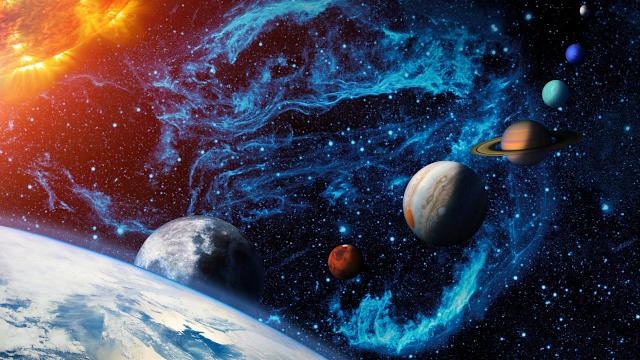Nebulae are vast clouds of gas and dust in space that contain crucial processes governing the birth, development, and death of stars. These structures are one of the main areas of research for astronomers who study the various stages of a star’s life cycle. The complex and rich nature of nebulae shows their significant role in astronomy. Each nebula has unique characteristics and natural forms, making its position and influence in space even more fascinating. They not only create the conditions for star formation but also encompass the factors that determine how existing stars will evolve up to their final stages. These examples of beauty and chaos in space also offer many possibilities for future discoveries in astronomy.
Nebulae come in various types: primarily “star-forming nebulae,” which cause the creation of stars, and “planetary nebulae,” which are remnants of dead stars. Star-forming nebulae often result from the interaction between wandering stars and gas clouds. Over time, these clouds evolve, and gases and dust come together to create an environment conducive to star formation. On the other hand, planetary nebulae remain after the death of stars, and these remnants form when the outer layers of a star slowly dissipate.
These magnificent and intricate structures in space not only ensure the birth of stars but also cover vital factors for understanding the final stages of a star’s life cycle and its evolution. For example, the matter in nebulae can transform into other types of stars or exotic objects as a star nears the end of its life, providing astronomers with deeper insights into the life cycle and evolution of stars.
The various forms, colors, and structures of nebulae make them both beautiful and scientifically valuable. Many nebulae emit light in different wavelengths, primarily from hydrogen and other elements, allowing astronomers to observe them and capture images in different colors. This beauty also increases their use in scientific research. By studying these structures, astronomers attempt to understand the behaviors of stars and other objects in different stages of space.
Additionally, nebulae offer astronomers valuable information about the presence and distribution of elements necessary for the origin of life in space. Nebulae may also carry traces of mysterious factors such as dark matter and dark energy, which are not fully understood. Therefore, nebulae provide a wide range of opportunities for future discoveries and research, playing a significant role in the advancement of astronomy. They are not only responsible for the birth and death of stars but also leave an irreplaceable mark in understanding the origin of space and life.
Classification of Nebulae
Nebulae are divided into various categories, typically linked to different stages in the life cycle of stars or star systems. Emission nebulae are often clouds of gas and dust that glow from the ultraviolet light emitted by young and hot stars. These nebulae glow because the hydrogen in them ionizes from the energy emitted by the stars. Stars are born within these clouds, grow, and, as the stars’ life cycles complete, the nebulae themselves change. The most famous example of an emission nebula is Orion, a region of intense star formation. Reflection nebulae, instead of emitting their own light, reflect the light of nearby stars. They usually appear blue because blue light is more easily reflected due to its shorter wavelength. These nebulae do not form new stars but instead take advantage of the light from existing stars. For instance, the reflection nebulae surrounding the Pleiades (Seven Sisters) fall into this category. Dark nebulae are dense clouds of gas and dust that absorb and block light, typically located in regions where star systems have yet to form but may eventually lead to new star creation. These nebulae often appear as silhouettes against the background stars. A well-known example of dark nebulae is Bok globules. Planetary nebulae form during the final stages of a medium-sized star’s life. These stars do not explode in a supernova but instead shed their outer layers, which spread into the surrounding space, leaving behind a small, dense “white dwarf” star. Despite their name, planetary nebulae have no actual connection to planets. The Dumbbell Nebula is one of the most famous examples. Supernovae are the explosive end of massive stars’ life cycles. After the explosion, the remaining matter expands into a supernova remnant, which is a cloud of material rich in heavy elements and radiation. The Crab Nebula is a well-known example of this type of nebula. These remnants leave lasting, high-energy traces in space.
Importance of Nebulae
Nebulae are crucial to our understanding of how the universe forms and evolves because they are directly tied to the birth and death of stars. They are also regions where new elements are formed. For example, stars transform hydrogen into helium through nuclear reactions, and the heavier elements (carbon, nitrogen, oxygen, etc.) produced during these reactions are distributed throughout space via nebulae. These elements form the essential building blocks of life. Hence, nebulae are also vital sources for the formation of new planets capable of sustaining life.
Nebulae are crucial because they are tied to the birth, development, and death of stars, which are essential for understanding how the universe evolves. Since stars’ life cycles and their death processes occur within nebulae, these objects are key to our comprehension of the development of the universe. During their life cycles, stars produce energy and matter through nuclear reactions. These reactions convert hydrogen into helium and heavier elements like carbon, nitrogen, and oxygen, which are essential for life. As stars approach the end of their lives, these elements are dispersed into space, creating the necessary materials for the formation of new stars and planets.
Furthermore, nebulae are essential in the formation of new planets capable of sustaining life. When stars die, the energy released from these explosive events, such as supernovae, spreads heavy elements throughout space, enabling the formation of new stars, planets, and other cosmic objects. The new star systems formed in this way increase the likelihood of creating environments suitable for life. These processes are critical for the formation of carbon-based life and other essential elements.
Additionally, nebulae provide a critical perspective on the universe’s evolution because new elements and molecules form there. This creates the “genetic material” for life, which eventually contributes to the formation of new star systems. Nebulae, therefore, serve as a crucial source for planets that may host life.
Physics of Nebulae
The physical properties of nebulae are diverse and of great interest in many research fields. The temperature of nebulae can vary significantly. For example, in emission nebulae, the gas temperature can exceed 10,000 K due to ionization, while dark nebulae may be much colder, sometimes dropping to -260°C. Nebulae are studied not only in optical light but also through radio waves, infrared, and X-rays. These different wavelengths help astronomers better understand the various layers and properties of nebulae.
Many nebulae also exhibit strong magnetic fields, which influence the movement of gas and dust and can affect the processes that lead to the birth of new stars.
Nebulae are vast clouds of gas and dust with a wide range of physical characteristics. Their temperature, composition, and structure can vary greatly. Some nebulae have high temperatures due to ionization, indicating they are regions where stars are forming. Other nebulae can be so cold that their temperature drops to -260°C, which indicates they are dark and have minimal interaction with their environment.
The study of nebulae is not limited to visible light. Experts use various electromagnetic waves to gain a deeper understanding of the physical and chemical structure of nebulae. Optical wavelengths provide an overall image of the nebula, but they do not allow detailed analysis. X-rays and infrared radiation help astronomers gather more information about star formation and the dynamics of nebulae. For instance, infrared radiation can reveal how dust and gas are starting to accumulate within a nebula and how new stars are forming.
In addition, many nebulae have strong magnetic fields that influence the movement of gas and dust, altering the nebula’s structure and evolution. These magnetic fields affect the interactions between particles, shaping the nebula’s development and, consequently, the formation of stars.









